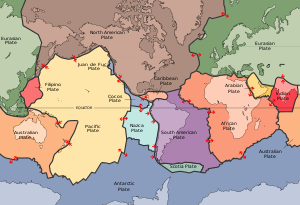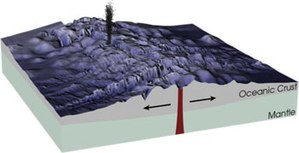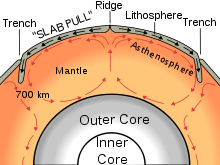Mid-ocean ridge
From Wikipedia, the free encyclopedia
| This article needs additional citations for verification. Please help improve this article by adding reliable references. Unsourced material may be challenged and removed. (October 2007) |
A mid-ocean ridge or mid-oceanic ridge is an underwater mountain range, typically having a valley known as a rift running along its spine, formed by plate tectonics. This type of oceanic ridge is characteristic of what is known as an oceanic spreading center. The uplifted sea floor results from convection currents which rise in the mantle as magma at a linear weakness in the oceanic crust, and emerge as lava, creating new crust upon cooling. A mid-ocean ridge demarcates the boundary between two tectonic plates, and consequently is termed a divergent plate boundary.
The mid-ocean ridges of the world are connected and form a single global mid-oceanic ridge system that is part of every ocean, making the mid-oceanic ridge system the longest mountain range in the world. The continuous mountain range is 65,000 km (40,400 mi) long and the total length of the system is 80,000 km (49,700 mi)[1].
Contents[hide] |
[edit] Description
Mid-ocean ridges are geologically active, with new magma constantly emerging onto the ocean floor and into the crust at and near rifts along the ridge axes. The crystallized magma forms new crust of basalt and gabbro.
The rocks making up the crust below the sea floor are youngest at the axis of the ridge and age with increasing distance from that axis. New magma of basalt composition emerges at and near the axis because of decompression melting in the underlying Earth's mantle.
The oceanic crust is made up of rocks much younger than the Earth itself: most oceanic crust in the ocean basins is less than 200 million years old. The crust is in a constant state of "renewal" at the ocean ridges. Moving away from the mid-ocean ridge, ocean depth progressively increases; the greatest depths are in ocean trenches. As the oceanic crust moves away from the ridge axis, the peridotite in the underlying mantle cools and becomes more rigid. The crust and the relatively rigid peridotite below it make up the oceanic lithosphere.
[edit] Formation processes
There are two processes, ridge-push and slab-pull, thought to be responsible for the spreading seen at mid-ocean ridges, and there is some uncertainty as to which is dominant. Ridge-push occurs when the weight of the ridge pushes the rest of the tectonic plate away from the ridge, often towards a subduction zone. At the subduction zone, "slab-pull" comes into effect. This is simply the weight of the tectonic plate being subducted (pulled) below the overlying plate dragging the rest of the plate along behind it.
The other process proposed to contribute to the formation of new oceanic crust at mid-ocean ridges is the "mantle conveyor" (see image). However, there have been some studies which have shown that the upper mantle (asthenosphere) is too plastic (flexible) to generate enough friction to pull the tectonic plate along. Moreover, unlike in the image above, mantle upwelling that causes magma to form beneath the ocean ridges appears to involve only its upper 400 km (250 mi), as deduced from seismic tomography and from studies of the seismic discontinuity at about 400 kilometers. The relatively shallow depths from which the upwelling mantle rises below ridges are more consistent with the "slab-pull" process. On the other hand, some of the world's largest tectonic plates such as the North American Plate are in motion, yet are nowhere being subducted.
The rate at which the mid-ocean ridge creates new material is known as the spreading rate, and is generally measured in mm/yr. The common subdivisions of spreading rate are fast, medium and slow, whose values are generally >100 mm/yr, between 100 and 55 mm/yr and 55 to 20 mm/yr, respectively for full rates. The spreading rate of the north Atlantic Ocean is ~ 25 mm/yr, while in the Pacific region, it is 80–120 mm/yr. Ridges that spread at rates <20>
The mid-ocean ridge systems form new oceanic crust. As crystallized basalt extruded at a ridge axis cools below Curie points of appropriate iron-titanium oxides, magnetic field directions parallel to the Earth's magnetic field are recorded in those oxides. The orientations of the field in the oceanic crust record preserve a record of directions of the Earth's magnetic field with time. Because the field has reversed directions at irregular intervals throughout its history, the pattern of reversals in the ocean crust can be used as an indicator of age. Likewise, the pattern of reversals together with age measurements of the crust is used to help establish the history of the Earth's magnetic field.
[edit] Discovery
Because a mid-ocean ridge is submerged at very deep depths in the ocean, its existence was not even known until the 1950s, when it was discovered through surveys of the ocean floor conducted by research ships.
More specifically, the Vema, a ship of the Lamont-Doherty Earth Observatory of Columbia University, traversed the Atlantic Ocean, recorded data about the ocean floor from the ocean surface. A team led by Marie Tharp and Bruce Heezen analyzed the data and concluded that there was an enormous mountain chain running along the middle of the Atlantic. The mountain range was named the Mid-Atlantic Ridge; it remains the most famous part of the mid-ocean ridge. It is the reason for the "mid-ocean" part of the title of this article, since it is only in the Atlantic that the ridge system is in the center of the ocean.
At first, it was thought to be a phenomenon specific to the Atlantic Ocean, because nothing like such a massively long undersea mountain chain had ever been discovered before. However, as surveys of the ocean floor continued to be conducted around the world, it was discovered that every ocean contained parts of the mid-ocean ridge.
[edit] Impact

Alfred Wegener proposed the theory of continental drift in 1912. However, the theory was dismissed by geologists because there was no mechanism to explain how continents could plow through ocean crust, and the theory became largely forgotten.
Following the discovery of the mid-ocean ridge in the 1950s, geologists faced a new task: explaining how such an enormous geological structure could have formed. In the 1960s, geologists discovered and began to propose mechanisms for sea floor spreading. Plate tectonics was a suitable explanation for sea floor spreading, and the acceptance of plate tectonics by the majority of geologists resulted in a major paradigm shift in geological thinking.
It is estimated that 20 volcanic eruptions occur each year along earth's mid-ocean ridges and that every year 2.5 square kilometers of new sea floor is formed by this process. With a crustal thickness of 1 to 2 kilometers, this amounts to about 4 cubic kilometers of new ocean crust formed every year.[citation needed]
[edit] List of oceanic ridges
- Chile Rise
- Cocos Ridge
- East Pacific Rise
- Explorer Ridge
- Gakkel Ridge (Mid-Arctic Ridge)
- Gorda Ridge
- Juan de Fuca Ridge
- Mid-Atlantic Ridge
- Pacific-Antarctic Ridge
- Reykjanes Ridge
- Central Indian Ridge
- Southeast Indian Ridge
- Southwest Indian Ridge



No comments:
Post a Comment